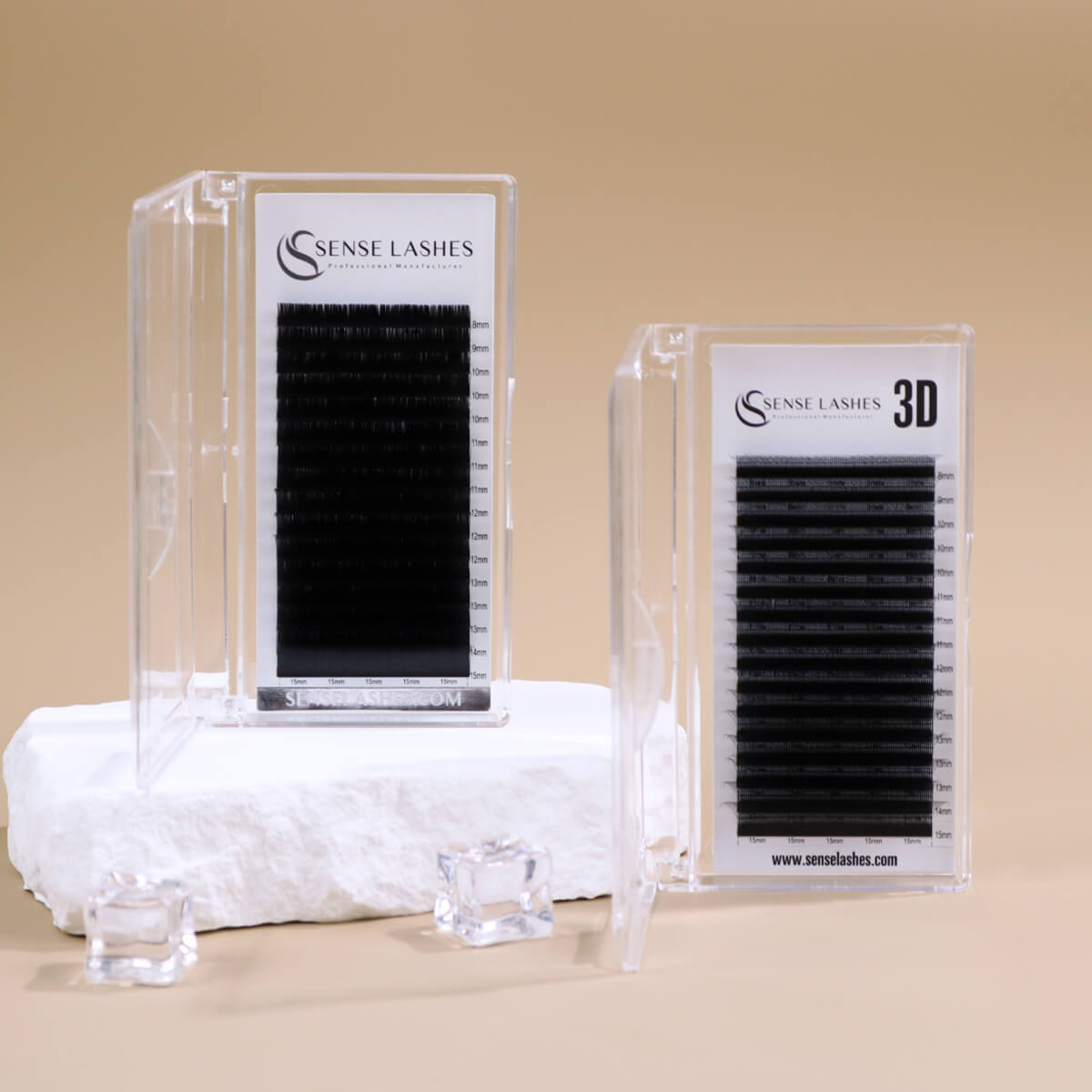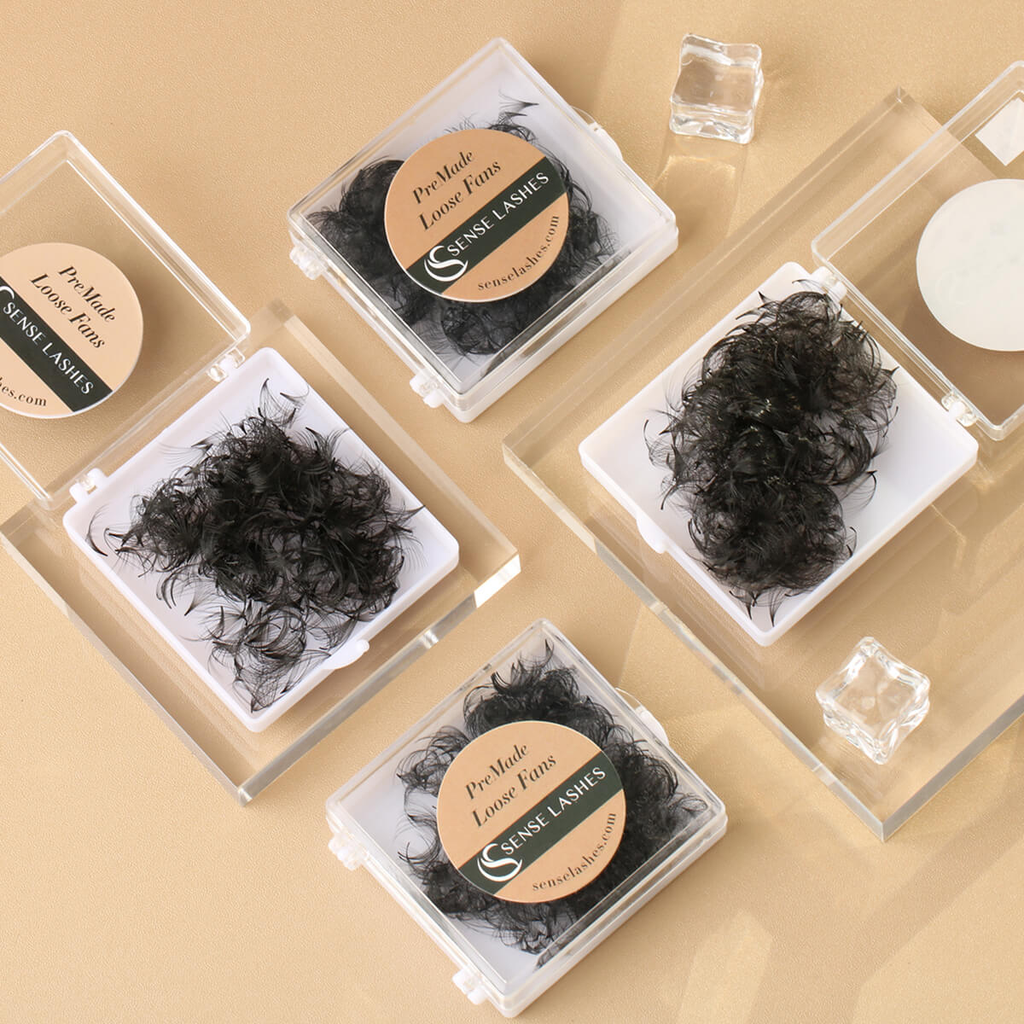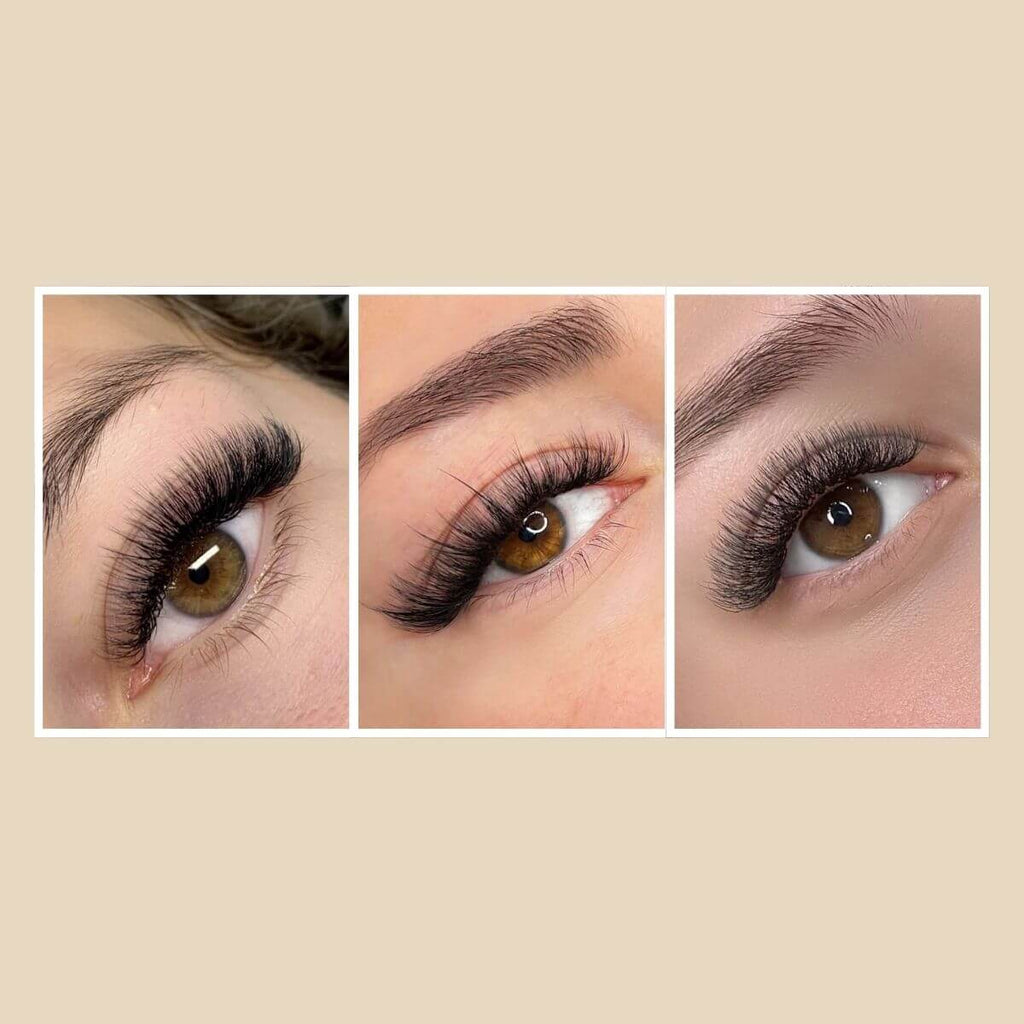Loose vs Tray Premade Volume Fans: The Practical Buyer’s Guide for Lash Artists
Premade volume fans have gone from “nice extra” to everyday staple in many lash rooms, and the format you choose can shape your whole day. Some artists swear by loose premade fans for the control and creativity they offer, while others rely on tray premade fans to keep timing tight and results consistent across clients. If you’re trying to decide which option fits your hands, your clients, and your booking style, it helps to look closely at how each format actually works in real studio life.
Why Premade Volume Fans Matter for Today’s Lash Artists
Volume clients expect full, fluffy sets in a reasonable time. At the same time, many lash artists are juggling back-to-back appointments, training new staff, and trying to keep retention solid. Premade volume fans sit right in the middle of all that.
Used well, premade volume fans cut set time, keep results more consistent across different techs, and take some pressure off newer artists who haven’t mastered hand-made fanning yet. The real question is not “are premades good or bad,” but which format—loose or tray—fits your daily workflow, experience level, and business goals.

What Are Premade Volume Fans and How Are Promade Fans Different?
Premade Lash Fans vs Handmade Volume Fans
Classic lashes use one extension per natural lash. Volume sets use a fan of several thin extensions placed on one natural lash. Traditionally, artists created those fans by hand, right on the spot, using pinching or wiggle techniques. That gives full control but takes time and skill.
Premade volume fans are fans that are manufactured in advance. The lashes are joined at the base with heat or a tiny amount of adhesive, then packaged so you can pick them up and place them directly. You still apply them one fan at a time, but you skip the fanning step.
Handmade fans:
- Maximum control over width, direction, and “texture”
- Longer learning curve and more tiring for long days
Premade fans:
- Faster sets and easier training
- Less freedom to change fan shape on the fly
Both can give beautiful results if the basics (weight, base control, glue usage) are correct.
Premade vs Promade vs Easy Fans – Quick Overview
These terms get mixed up a lot, so a quick clear view helps:
- Premade fans: Factory-made in bulk, bases pre-bonded, sold loose in jars or arranged on strips in trays.
- Promade fans: Usually hand-made by an artist in advance, then stored to use later. Many artists now also call some high-quality loose fans “promade,” especially when they have very fine bases and a handmade look.
- Easy fans: Lashes on a strip that “self-fan” when you pick them up. You still do a bit of shaping, but the strip is designed to help the fibers separate.

Loose Premade Volume Fans – How They Work and When They Shine
Packaging and Fan Structure of Loose Premade Fans
Loose premade volume fans are packaged in small jars or boxes. Inside, the fans are not attached to a strip. They sit freely, base down or mixed together, and you pick them up straight from the container or from a lash tile where you’ve laid them out.
Each fan is:
- Made from several very thin fibers (for example 3D–10D)
- Joined at the base with heat or a very small amount of glue
- Designed to hold its shape when you grip it with tweezers and dip in adhesive
The structure can vary a bit by manufacturer. Some loose fans are narrow with long stems. Others have short stems with a wide, fluffy spread. That variety can be a plus for artists who like playing with different textures.
Advantages of Loose Premade Fans for Experienced Lash Artists
Many advanced artists like loose premade fans because they feel closer to working with handmade fans. Key upsides include:
- Freedom of pickup angle: You can grab the fan from almost any direction. That makes it easier to adjust the fan to different eye shapes, tricky inner corners, or detailed lash mapping.
- Great for custom and textured sets: Loose fans work well for wispy, spiky, or mixed-dimension designs. You are not tied to a strip layout, so swapping between different dimensions and stem styles feels natural once you are used to it.
- Often lower cost per fan: Jars of loose premade fans usually come in higher quantities (for example 500–1,000 fans), which often means a better price per fan compared to some trays. For high-volume artists, that price difference can add up over time.For artists who already work quickly and want more control over style, loose fans can fit that “creative control plus speed” balance.
Common Challenges with Loose Premade Fans
There are trade-offs. Loose premade fans are not always beginner-friendly. Common issues include:
- Extra setup time: Fans need to be poured out, sorted, and placed on a silicone pad or lash tile. That’s one more step during prep and between clients.
- Organization: Without clear rows and labels, it’s easy to mix lengths or curls. If several jars are open at once, fans can get mixed or knocked over.
- Overwhelm for newer techs: For someone still learning volume, digging through a pile of loose fans can feel stressful. It is harder to spot exact sizes and keep a clean, repeatable pattern across the lash line.
Good habits, like labeling tiles clearly and only working with one or two sizes at a time, can solve a lot of these problems. But it still asks more from the artist than a simple tray layout.

Tray Premade Volume Fans – Why They’re a Studio Staple
Tray Layout, Strip Adhesive, and Fan Consistency
Tray premade fans look similar to classic lash trays. Fans are attached to sticky strips, arranged in neat rows. Each row contains one length, curl, and diameter. Labels make it easy to see what you’re picking up.
This format gives:
- Consistent base shape and width
- Symmetrical fan spread along each row
- Clear visual structure from the moment you open the box
Because everything is lined up, you spend less time sorting and more time actually lashing.
Benefits of Tray Premade Fans for Speed and Training
Tray premade fans are popular in busy studios for good reasons:
- Fast setup: You peel the strips and place them on your palette. That’s usually it. Lengths and curls are already labeled, so there’s less guesswork.
- Easier for new artists: The consistency helps beginners learn what a good fan looks like and how much glue to use. It’s easier to spot when bases are too chunky or when too much adhesive is being picked up.
- Stable timing for bookings: When staff use the same tray system, it’s easier to estimate how long a full set or fill will take. That helps with scheduling and pricing across the team.
For managers and owners, trays often mean fewer surprises and more predictable results.
Drawbacks and How to Avoid Them
Tray fans also have weak spots, mostly related to the strip adhesive and quantity:
- Residue on the base: If the strip is too sticky, peeling fans off can leave adhesive on the base. That may affect bonding if a fan is not cleaned or if extra glue is added on top of residue.
- Bent or twisted bases: Rough removal from the strip can bend bases or distort the fan. That can hurt retention and make sets look uneven.
- Limited quantity per tray: Some trays don’t hold enough of one size for multiple full sets, so several trays may be needed to keep stock steady.
Simple solutions help: peeling fans from the side instead of straight up, testing new brands for strip stickiness before buying big, and choosing trays designed with clean, narrow bases.

Loose vs Tray Premade Fans: Side-by-Side Comparison
Application Speed and Ease of Use
For pure speed, tray premade fans usually come out ahead. Less sorting, less setup, and quicker identification of lengths and curls all shave time off each appointment.
Loose fans can still be fast in the hands of an experienced artist, especially if the setup on the tile is planned well. But most beginners and many busy techs find that trays make it easier to move smoothly through a set without stopping to search for the right fan.
Set Style, Density, and Client Results
Both formats can create full, beautiful volume sets. The difference is mainly in how easily you can push style in specific directions:
-
Loose fans are great when you want:
- Dense or mega volume
- Textured and wispy maps
- Quick mixing of different dimensions across one eye
-
Tray fans are ideal when you want:
- Balanced, even volume
- Salon menu styles that look similar from client to client
- Clear “before and after” consistency across artists
If your brand focuses on signature, highly customized looks, loose fans might feel more natural. If your studio leans on menu sets and fast repeats, tray fans often make more sense.
Retention, Lash Health, and Base Control
Retention and natural lash health rely on several factors: correct weight, clean base, right glue amount, and proper isolation. Fan type interacts with those points in slightly different ways.
Tray fans usually have more uniform bases. That makes it easier to:
- Pick up a similar amount of glue each time
- Place the fan at a consistent angle
- Avoid bulky, heavy bases that pull on natural lashes
Loose fans may show more variation from fan to fan. That’s not automatically a bad thing, but it demands closer visual checking and a steadier hand. If the bases are slightly more open, it’s easier to overload them with adhesive, which can increase weight and create stickies.
For newer artists, trays generally give a safer margin for error. For advanced artists, either format can be safe if weight and glue control are respected.
Which Premade Fan Type Fits Your Experience Level and Business Model?
New Lash Artists and Solo Beginners
For most beginners, tray premade fans are the smoother path. There’s already a lot to focus on: isolation, glue control, lash health, eye styling, client comfort. Reducing the mental load around fan selection helps.
Tray fans give new techs:
- A clear view of what a good, balanced fan looks like
- Simple labeling and structure
- More consistent retention while they build their skills
Once base placement, weight, and isolation feel solid, newer artists can experiment with loose fans for special looks.
Busy Salon Teams and High-Volume Booking
In a busy salon, each small delay adds up. For teams handling back-to-back clients, trays keep everyone on the same system.
Tray premade fans often work best as the main workhorse for standard sets and fills. They:
- Make training faster
- Keep set times predictable across the team
- Simplify restocking and storage
Loose fans can still be part of the setup, for example on specific service tiers (mega volume or “signature texture” upgrades) handled by more experienced artists.
Advanced Artists Building Signature Looks
Once an artist is confident with volume, loose fans become very interesting. They allow more control over:
- Mixing different dimensions in one section
- Creating soft spikes, layers, and texture
- Adjusting angles for unusual eye shapes or problem areas
Many advanced artists mix things up: they use tray premades for the base of the set, then add loose fans in certain zones for extra depth or a special “branded” look. The right choice depends on how you like to design and how much time you want to spend per client.
Loose vs Tray Premade Volume Fans – Quick Decision Checklist
3 Questions to Ask Before You Buy
A simple way to choose is to ask yourself:
- How many clients do I see in a typical day or week?
- Do I care more right now about speed or about customizing every set?
- Where am I in my skill journey with volume and retention?
Your honest answers already point strongly toward one format or a mix of both.
Quick Recommendations
- If you are new to volume, or your schedule is tight and every minute counts, tray premade fans are usually the smarter first choice.
- If you are experienced, love creative mapping, and want lower cost per fan for dense or mega sets, loose premade fans are worth the extra setup time.
- Many studios see the best results by stocking both types: trays for daily bread-and-butter sets, loose jars for advanced or premium services.
7 FAQs About Premade Volume Fans
Q1. Are premade volume fans safe for natural lashes?
Yes, premade volume fans can be safe as long as the basics are right. The diameter of each lash in the fan must be thin enough, the overall weight must match the client’s natural lash strength, and the base needs to be placed correctly with the right amount of adhesive. Problems usually come from heavy fans, poor isolation, or bad glue habits—not from the fan format itself.
Q2. Do premade lash fans have worse retention than handmade volume fans?
Retention depends more on application than on whether a fan is premade or handmade. Clean natural lashes, proper prep, correct glue amount, and solid base contact all matter more. High-quality premade fans with neat, narrow bases can hold just as well as handmade fans when applied properly. Poor quality premades with bulky bases, or rushed application, can hurt retention.
Q3. Are loose premade fans harder to work with than tray fans?
For many beginners, yes. Tray fans feel more straightforward because they are already lined up, labeled, and easy to see. Loose fans demand more organization and a bit more confidence in picking and placing. Once an artist is experienced, the difference becomes smaller, and loose fans may even feel more flexible and natural to use.
Q4. How many premade fans do I need for a full volume set?
It depends on the client’s natural lash line and the style. A typical full volume set often uses somewhere around 300–500 fans, but some clients need fewer and some need more. Dense or mega volume sets, or eyes with a lot of natural lashes, will use more fans. Tracking your own average per client over a few weeks gives the best number for your studio.
Q5. Can I mix premade fans with classic lashes in a hybrid set?
Yes. Many artists create hybrid sets by mixing classic extensions and premade fans. For example, classics can be used along the lash line as a base, then premade fans are added for fullness in specific zones. The key is matching curls and diameters so the set looks blended, and keeping the overall weight safe for the natural lashes.
Q6. What’s the difference between premade, promade, and easy fans in real studio use?
In real life, premade fans are the most “plug-and-play,” coming ready to apply in jars or trays. Promade fans are usually seen as higher-end or more natural-looking, often made or finished by hand before being stored. Easy fans are for artists who still want to build their own fans but like a little help from the strip design. The right choice comes down to how much control you want and how much time you have.
Q7. Which premade fans are best for beginners vs advanced lash artists?
Beginners usually do best with tray premade fans that have narrow, tidy bases and clear labeling. That format keeps things simple and supports good habits. Advanced artists can get strong value from loose premade or promade fans, especially when building textured or mega volume looks and watching cost per set. Many artists move from tray to a mix of tray and loose fans as their skills and client base grow.
Build a Premade Fan Collection That Grows With Your Business
Loose and tray premade volume fans are tools, and each has a clear place in a modern lash studio. Trays keep things fast, clean, and beginner-friendly. Loose fans offer more freedom and often better value for customized or high-density sets. The best approach is to match the format to your current skills, your booking style, and your brand promise, then adjust as your business grows. Over time, tracking set time, retention, and client feedback with each type will show you exactly which premade fans deserve a permanent spot on your lash cart.





Leave a comment